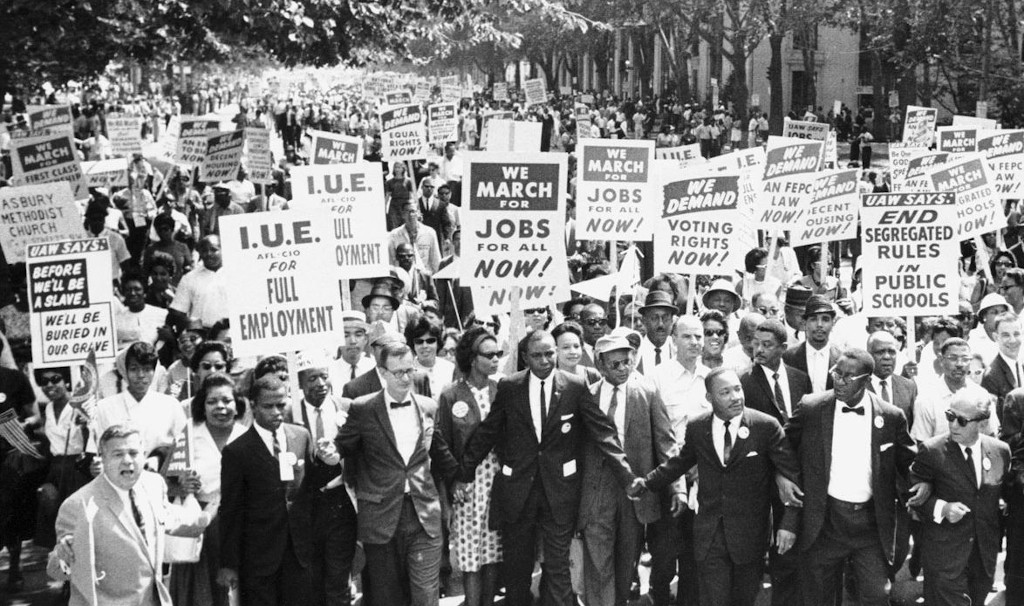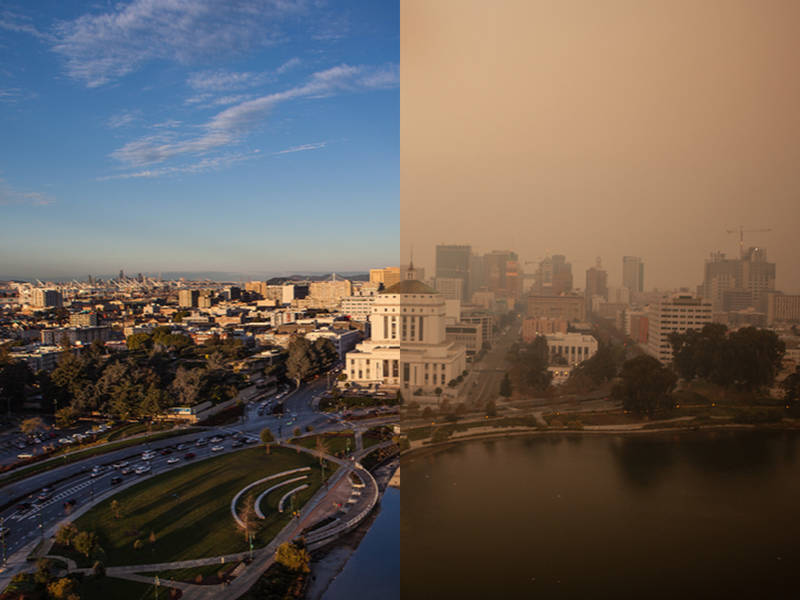Eljeer Hawkins is a member of Socialist Alternative in the US.
Martin Luther King moved from a position for a gradual reform of capitalism towards an understanding that more radical ideas were needed. The 50th anniversary of the historic March on Washington for jobs and freedom falls on 28 August 2013. It was on this 250,000-strong march that Martin Luther King gave his famous ‘I have a dream’ speech from the steps of the Lincoln Memorial. Eljeer Hawkins, an activist in Socialist Alternative in the US, provides the history behind the event. The mass movements for civil rights which came before and after the march won victories against the brutal racist system that existed in the US. However, the enormous courage and determination of the workers and the youth who participated were often let down by the tactics of their leaderships. King himself moved from a position of passive resistance and for a gradual reform of capitalism towards an understanding that more radical ideas were needed. Even in 1964, following the successful passage of the Civil Rights Act Martin Luther King said: “Now our struggle is for genuine equality, which means economic equality. “For now we know that it isn’t enough to integrate lunch counters. What does it profit a man to be able to eat at an integrated lunch counter if he doesn’t earn enough money to buy a hamburger and a cup of coffee?” The commemoration of this landmark day is taking place in a period of unprecedented attacks by big business and its two parties, Democratic and Republican, on the rights fought for and won by militant social struggle of working people, youth, and particularly black workers and youth.Jim Crow
’Jim Crow’ became the common term to refer to the institutionalized segregation, oppression and political exclusion of blacks in the South. The Jim Crow laws lasted between 1876 and 1965. After the American civil war (1861-65) the radical ’reconstruction’, an experimental period of “multi-racial democracy”, brought land reform and voting rights for blacks and poor whites. Northern capitalists backed the movement of poor whites and blacks that fought for this – to a point. However, once the Northern capitalists consolidated their victory over the Southern plantation owners and were confident of their power they allowed Southern big business a freer rein. The end of ’reconstruction’ coincided with the electoral crisis and great compromise between the Democratic and Republican parties in 1877 which brought the return of the former slave owning planter class in the south. A tiny, rich, white elite in the south sought to re-establish its power over property, political, social and economic life. Working and poor people, particularly black workers, lost many education and voting rights, as well as access to jobs. The Ku Klux Klan was unleashed to carry out a reign of terror on black people, as well as civil rights, labour movement and left activists. ’Lynch law’, state sponsored and extra-judicial violence, inflicted the reality of no rights for black people. Throughout the years of Jim Crow, the black freedom movement wasn’t docile in the face of the violence, fervent racism and divide and conquer tactics used by big business. The black freedom movement fought tooth and nail through organizations which included the Brotherhood of Sleeping Car Porters union, the Communist Party USA, the National Association for the Advance for Colored People (NAACP), which concentrated on legal change, and in the labour movement. These organizations laid the basis for the modern civil rights movement.The precedents
The call to go to Washington DC has a long history, dating back to the Veterans’ Bonus March of 1932 in the midst of the Great Depression. The World War One veterans’ encampment demanded economic compensation for service during the war. A large proportion of those who went abroad to fight in World War Two were black. This had an effect as black soldiers were struck by the glaring hypocrisy of the war propaganda. The US capitalist class claimed it was sending men to Europe to fight against the racism of the Nazis – while at home vicious racism was the norm. Most military units were segregated. The labour shortage resulting from the war meant black people got jobs in industry that were previously unavailable to them, as did women. During the war, in the period of economic growth that existed in the US, there was a big movement of black workers into the cities, also bringing changes to their ability and confidence to organize and struggle. It also brought the poverty levels suffered by the black population into sharp relief. This, and the anti-colonial struggles of the masses in Africa and Asia at that time, brought greater confidence to resist the racist Jim Crow laws. The 1941 March on Washington Movement, led by labour leader and socialist A Philip Randolph, demanded the end of racial discrimination within the war industry. There were 50,000 paid-up members of the movement but the march never took place. President Roosevelt capitulated to the rising pressure and issued Executive Order 8802, which banned racial discrimination in government employment, defence industries and training programs. This was an important victory that was preparation for the movement of the 1950s and 60s but it was a mistake to cancel the march – which could have had a greater impact. Further victories came in 1954 when the Brown v Board of Education decision ended the separate and unequal doctrine of Jim Crow within America’s educational system. On 28 August 1955, Emmett Till was lynched and brutally beaten for allegedly whistling at a white woman. The 14 year old black youth from Chicago was visiting family in Mississippi. Mamie Till made the heart-breaking and powerful decision to have an open casket so the world could see the violence of Jim Crow. Mamie’s gut-wrenching statement became a rallying cry for workers and youth – particularly black workers, poor people and youth to challenge Jim Crow. Three months later Rosa Parks, a garment worker in Alabama refused to give up her bus seat to a white man. She was arrested and the Montgomery Bus Boycott movement against Jim Crow and segregation followed. King, a local preacher, came to prominence in this movement. The bus boycott was 100% successful and after another year of struggle, again in the face of vicious violent attacks, the desegregation of the buses in Montgomery was achieved.The march
Leading up to this historic day there were important and bloody battles in Albany, Georgia and Birmingham, Alabama; the heroic Freedom Riders struggled bravely for the de-segregation of terminal facilities and buses on interstate highways; there were sit-in strikes and the killing of NAACP Mississippi leader Medgar Evers. The struggles of the 1950s culminated in the 1957 Civil Rights Act, which was, however, seen by the movement as a token gesture. In the midst of state sponsored and white vigilante violence the church-led Southern Christian Leadership Council (SCLC), of which King was a member, and the college youth-led Student Nonviolent Coordinating Committee (SNCC) were born. Although most of the SCLC leaders were preachers and pacifists it was based on mass action and supported direct acts of civil disobedience. On a hot and humid day 250,000 people from around the country, predominately black workers and youth, gathered in front of the Lincoln memorial to demand an end to Jim Crow apartheid in education, voting, healthcare, jobs and housing. The earlier phase and character of the civil rights movement was linked to the Democratic Party and was dominated by reformist politics. The aim of the movement was to embarrass the US government during the post-World War Two economic upswing to win legal equality. President John F Kennedy’s administration was seen as a ’friend’ to the movement. But it sought to control the leadership and organisations of the civil rights movement. In fact SNCC chairperson John Lewis was forced to change his fiery speech by march organisers, dropping his criticism of the Kennedy administration. His original draft included the following: “We march today for jobs and freedom, but we have nothing to be proud of. For hundreds of thousands of our brothers are not here. They have no money for their transportation, for they are receiving starvation wages… or no wages at all… Mr Kennedy is trying to take the revolution out of the street and put it in the courts. Listen Mr Kennedy… The black masses are on the march for jobs and freedom and we must say to the politicians that there won’t be a cooling-off period.”Speech

1963
A great debate ensued within the black freedom movement led by figures such as Malcolm X, initially of the Nation of Islam (NOI), and the Detroit based Freedom Now Party over the weakness and strategy of the movement. This layer of militant leadership posed questions of political independence from the two-party system, internationalism, supporting the anti-colonial revolution and reaffirming African Americans’ sense of self-worth. The black nationalist and socialist activists would point out racial justice couldn’t be secured as long as big business and white supremacy dominated the means of production and industry. Following the death of President Kennedy in November, given the social power and pressure on US capitalism by the black freedom movement and international events President Lyndon Baines Johnson introduced new laws. Segregation in Alabama was defeated and a new Civil Rights Act passed in 1964 and the Voting Rights Act in 1965. One of King’s greatest contributions as a civil rights leader was his argument against black separatism. He instead called for a coalition with poor and working class whites: “Within the white majority there exists a substantial group who cherish democratic principles above privilege and who have demonstrated a will to fight side by side with the Negro against injustice. Another and more substantial group is composed of those having common needs with the Negro and who will benefit equally with him in the achievement of social progress. There are, in fact, more poor white Americans than there are Negro. Their need for a war on poverty is no less desperate than the Negro’s.” King understood the collective power of workers in workplaces. At the time of his assassination he was founding a movement against poverty. He was also becoming actively involved in supporting workers in struggle. For these reasons he was a major threat for US capitalism.Black Power
The black power movement and its organizations such as the Black Panther Party for Self-Defence, Revolutionary Action Movement and a radicalized SNCC under Chairperson Stokely Carmichael grabbed the attention of a new militant section of black workers and youth around the country. The black power movement, inspired by the international revolutionary struggles, posed the questions of self-determination, self-defence, and political and economic power, drawing on political philosophies ranging from socialism, revolutionary nationalism, to Maoism and black capitalism. Simultaneously, the black freedom movement would be met with governmental opposition under the auspices of the Counter Intelligence Program (Cointelpro), which sought to prevent the development of a unified radical movement and leadership. Cointelpro developed under the leadership of FBI chief J Edgar Hoover. The militant leadership and organizations of the black freedom movement would be drowned in blood by the forces of big business. It is impossible to place the radical Dr King, 21 year-old Black Panther Party leader Fred Hampton or Malcolm X in the same political space as Wall Street funded corporate politicians such as President Barack Obama. In order to sanitize the radical and revolutionary movements of the 1960s, the black freedom movement had to be extinguished or co-opted by capitalism and its two parties. The black freedom movement tore down the walls of legal segregation in the 1950s and 60s. The time is now to construct a new, sustaining, multi-ethnic mass movement that will fight back against racial and class oppression across the country. As Dr King said: “We are dealing with class issues. Something is wrong with capitalism… Maybe America must move towards democratic socialism.” Socialist Alternative in the US argues for the need to break from the two party system and build a mass party of the working class. Our city council election campaigns in Seattle, Minneapolis and Boston are examples of what must be done in this period of crisis to confront the agenda of Wall Street.The situation today
On 24 August up to 100,000 workers, youth and people colour gathered at the Lincoln memorial to commemorate the march on Washington. Unfortunately the organizers of the march attempted to contain and smother struggles against racial and class oppression. Attorney General Eric Holder and President Obama, corporatized black misleaders of the movement, gave keynote speeches but are the exact opposite of the powerful radical history of the black freedom movement and Dr King’s legacy. Socialist Alternative says: if we want to fight racism then we have to take on the whole system – capitalism! We draw inspiration from the tremendous “Moral Mondays” movement in North Carolina, the low wage workers’ campaigns around the country for a $15 living wage, the struggle of the teachers unions across the country, the Dream Defenders, and the protest rallies after the Zimmerman verdict. But the past five years under President Obama has brought the deadly consequences of the neoliberal austerity agenda of Wall Street and attacks on rights such as the erosion of safeguards against voter discrimination and suppression. Black workers, youth and the poor are also facing very grave conditions in healthcare, housing and education disparity.- 26% of black people live below the poverty line
- 45% of children born in the black middle class will end up in poverty
- 74% of black children still attend segregated schools
- Prison and police state
- There are 1.3 million black and brown women and men incarcerated out of 2.3 million prisoners, part of the over six million-strong under “correctional supervision” population in America
- The US accounts for 5% of the world’s population, but 23% of the world’s prisoners
- A black man is killed every 28 hours in the US by a cop or a vigilante
- Under Stop and Frisk 685,724 people were stopped in 2011, blacks and Latinos combined made up 78% of those stopped with 88% found innocent of any crime



